Key message:
- This year, we observed the hottest global surface temperature and the ocean temperature is heating too. It seems like each geographic location will face a different impact from climate change, and nowhere is safe. Climate change will make extreme events more frequent and severe.
- The global risk analysis ranked Indonesia 12th out of 35 countries facing a relatively high mortality risk from multiple hazards. Given its geographical location and environmental conditions, Indonesia is prone to flooding, landslides, droughts, and sea level rise. Java island is home to 56.7% of the total Indonesian population & where Jakarta’s highest economic drive among all other provinces is in danger from climate risks.
- Can we live on our planet without destroying it? Even after the international landmark Paris Agreement, despite the urgent need to cut emissions to slow climate change, the researchers say there is still “no sign” that the world has reached a peak in fossil CO2 emissions.
- In 2023, six of these planetary boundaries had already been crossed. Hubacek (2024) also stated that, at the moment, the richest 1% of the world’s population (approximately 63 million people) produces 50x more greenhouse gases than the 4 billion people in the bottom 50%.
———————————————————————————————–
Recent climate events
Climate doesn’t change in the blink of an eye; it is a slow but constant accumulation of emissions we have produced over the years (if we remember the lifetime of greenhouse gases (GHG) emissions). In 2024, we observed that the hottest global surface temperature increased by 1.62°C compared to the average temperature in 1850 and 1900. The ocean temperature is heating too; in the first half of this year, ocean surface temperature has soared (around +1°C) compared to the average sea surface temperature between 1991-2020. As a result, we experienced extreme rainfall in certain parts of the world. Warmer water caused a higher rate of evaporation, which induced the creation of clouds, intensified rainfall, and even devastating hurricanes. While some parts of the world might experience drought, nearly 50% of the global land area will be affected by extreme drought in 2024.
Figure 1. Land and ocean surface temperature changes
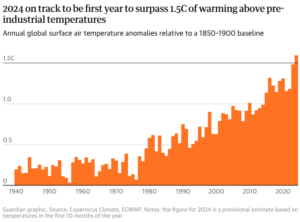
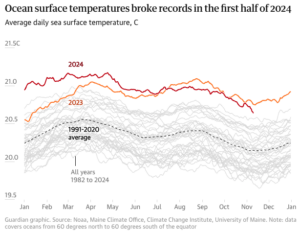
Source: The Guardian (2024) ‘The climate crisis in charts: how 2024 has set unwanted new records’. Available here.
Below are some recent extreme events that you might have experienced or heard over the news:
- A catastrophic tropical cyclone, Hurricane Helene, was in the United States in September 2024. Then we experienced the most extensive rain recorded in 24 hours since records started in 1949, Al Ain, UAE, in 2024. Before that, in Africa, in September 2023, Storm Daniel Libya caused at least 2,000 people to die. Two dams collapsed, sweeping away large chunks of the city and leaving outlying regions under water.
- Heatwave that killed more than 47,000 people last summer in Europe. Catastrophic bushfires during summer 2019-2020 in Australia. Up to 19 million hectares were burnt, with 12.6 million hectares primarily forests and woodlands. Nearly 3 billion animals were impacted by the blazes. Drought affected the biggest river in Asia, the Yangtze River, and in 2024, it was reported to be 60% below average in water level. Likewise, the world’s most remarkable tropical forest, the Amazon, has experienced drought and is struggling to recover.
Figure 2. Extreme climate events all over the world: Hurricane Helene (2024), Storm Daniel (2023), catastrophic bushfires in Australia (2019-2020), and drought in Yangtze River (2024)
- Source: https://www.britannica.com/event/Hurricane-Helene
- Source: https://www.voanews.com/a/thousands-feared-dead-from-libya-floods/7264628.html
- Source: https://wwf.org.au/what-we-do/australian-bushfires/in-depth-australian-bushfires/
- Source: https://www.weforum.org/stories/2023/10/drought-trade-rivers-supply-chain/
It seems like each geographic location will face a different impact from climate change, and nowhere is safe. Climate change will make extreme events more frequent and severe. The World Bank Group measured the climate risk country profiles to present a high-level assessment of physical climate risks for a country, providing insight for decision-makers into the potential for increasing, expanding, and emerging risks across space and time and for different climate futures. Let’s take the example of Indonesia, where the writer currently resides.
Indonesia’s potential
The global risk analysis ranked Indonesia 12th out of 35 countries facing a relatively high mortality risk from multiple hazards. Given its geographical location and environmental conditions, Indonesia is prone to flooding, landslides, droughts, and sea level rise. Java Island is home to 56.7% of the total population in Indonesia, 283,488,000 in 2024. According to a vulnerability mapping exercise, Java is a hotspot for multiple hazards like earthquakes, tsunamis, volcanic eruptions, floods, landslides, droughts, and forest fires. One of the main drivers in Java Island, Jakarta, the city serves as Indonesia’s economic, cultural, political, and administrative centre. In 2022, Jakarta generated a Gross Regional Domestic Product (GRDP) of more than three quadrillion Indonesian rupiah, the highest among all other provinces in the country. Jakarta’s economic landscape lies around the wholesale and retail trade sector, followed by manufacturing.
Dr Tri Mulyani Sunarharum, a member of the Planning Expert Panel of Nusantara Capital City 2024, shared in the lecture (Future Infrastructure Climate Change Challenge, University of Edinburgh, 30 September 2024) about the Jakarta disasters (shocks) potential that includes flood, fire, and earthquake. Floods are mainly caused by massive urbanisation that changes the land use from previously catchment areas to houses to fulfil the water needs of the inhabitants using water pumps. Water pump usage is causing land subsidence and other human activities. The rate of land subsidence at some locations in Jakarta can be as high as 20-28cm/year and has reached an accumulated subsidence of around 5m. The neighbourhood in Muara Baru, North Jakarta, has observed beach disappearance and frequent inundation.
Figure 3. Cumulative maximum land subsidence in significant cities in the Asia-Pacific Region
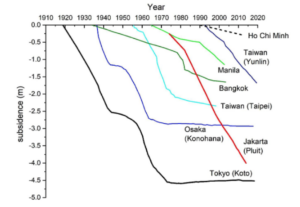
Source: Cao, A. et al (2021) ‘Future of Asian Deltaic Megacities under sea level rise and land subsidence: current adaptation pathways for Tokyo, Jakarta, Manila, and Ho Chi Minh City’. Available here.
Figure 4. Flooding, sea level rise, land subsidence reality in Jakarta
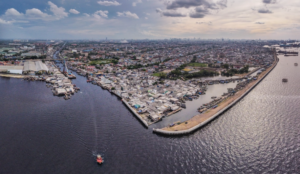
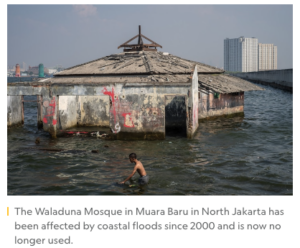
Source: National Geographic (2022). ‘Indonesia’s giant capital city is sinking. Can the government’s plan save it?’ Available here.
The government has grand master plans for Jakarta, such as a giant bird-shaped sea wall to protect it from rising sea levels and move the new capital to Borneo Island. But does it solve the root problem? Let’s say the centre of government moves to another island; what about the other inhabitants in the sinking city? Besides flooding and land subsidence, the inhabitants suffer from chronic traffic and choking air pollution. We haven’t even touched on the land use change in Borneo Forest to build the new capital.
Figure 5. Nusantara (Indonesia’s new capital city) land use changes captured between 2022 & 2024
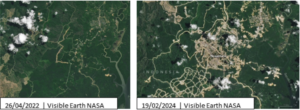
Source: Visible Earth , NASA. ‘Nusantara: A New Capital City in the Forest’. Available here.
Besides the plan to save the sinking capital city, Indonesia is vigorously reducing the poverty rate and bringing more prosperity to the inhabitants. To reduce the poverty rate, the Government of Indonesia has continued accelerating Cash Labor-intensive Program (Program Padat Karya) distribution to reduce unemployment and maintain people’s purchasing power amid economic uncertainty during the COVID-19 pandemic. Besides job creation, this program aims to improve infrastructure development to support the productivity of rural communities, such as enhancing minor irrigation, environmental roads, drinking water quality, and sanitation, establishing subsidised homes, and handling slums. With the vast changes in human activity, do we think we are moving in the right direction? Or are we driving towards climate catastrophe?
Paris Agreement checking
The Paris Agreement has been a landmark international treaty on climate change since 2015. Countries pledged to hold “the increase in the global average temperature to well below 2°C above pre-industrial levels” and pursue efforts “to limit the temperature increase to 1.5°C above pre-industrial levels.” by 2030. With only 5 years to go, how well are we doing? As one of the most significant contributors to GHG emissions, the graph below shows a considerable drop in fossil fuel emissions (coal and oil) after the Paris Agreement; however, slowly but surely, it is going up again. The later graph then describes the trend from each GHG emission, namely carbon dioxide, nitrous oxide, and methane, from year to year. Both showed that our emissions are still rising even after the Paris Agreement.
Recent science news published in Science Daily from the University of Exeter also supported this statement; despite the urgent need to cut emissions to slow climate change, the researchers say there is still “no sign” that the world has reached a peak in fossil CO2 emissions. The 2024 Global Carbon Budget projects fossil carbon dioxide (CO2) emissions of 37.4 billion tonnes, up 0.8% from 2023.
Figure 6. There are no signs of GHG emissions reduction despite the Paris Agreement in 2015
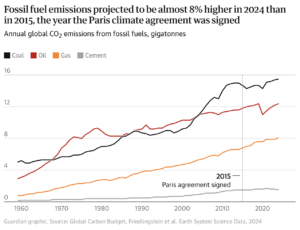
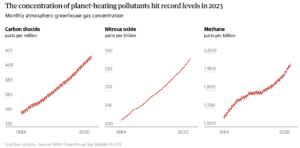
Source: The Guardian (2024) ‘The climate crisis in charts: how 2024 has set unwanted new records’. Available here.
Can we live on our planet without destroying it?
The University of Groningen (2024) raises a big question: “Can we live on our planet without destroying it?” Acknowledging that almost every activity we do has a carbon footprint embedded in it, perhaps, is a baby step to making a positive impact afterwards, from choosing the mode of transportation and electricity you use to selecting the products you consume.
Scientists, experts, and professionals have been trying to quantify the intangible emissions, hoping we can all be responsible. Accountability for your emissions works for your personal life and on a larger scale, i.e., community, business, and country. There is a limit to the amount of consumption the Earth can support, and in 2009, scientists defined nine ‘planetary boundaries’ as indicators of when we have reached that limit. Crossing them may lead to irreversible damage to the Earth’s stability and resilience. In 2023, six of these planetary boundaries had already been crossed. Hubacek (2024) also stated that, at the moment, the richest 1% of the world’s population (approximately 63 million people) produces 50x more greenhouse gases than the 4 billion people in the bottom 50%.
Figure 7. Planetary boundaries within which humanity can continue to develop and thrive for generations to come
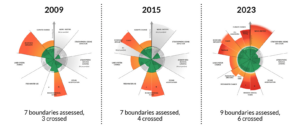
Source: Stockholm Resilience Centre (no date). ‘Planetary Boundaries’. Available here.
Hellweg, S. et al. (2023) argued that multiple actors, including policymakers, companies, and consumers, must make a joint effort to achieve the required transformational change. ‘Science-based targets’ are increasingly gaining popularity as an operational means to stay within planetary boundaries. Indicators and actionable methods are needed to measure specific targets for companies or nations, and Life Cycle Assessment (LCA) is considered a candidate for fulfilling this role in future. LCA is a method used to evaluate the environmental impacts of a product, process, or service throughout its entire life cycle—from raw material extraction to disposal. It helps identify and quantify the environmental burdens associated with each life cycle stage. Therefore, it would benefit policy-making and strategic decision-making, benchmarking and comparing products within the same category, regulatory compliance, and environmental labelling.
Exit plan?
There is no easy way to stop or slow global warming; however, we must put a break on human-caused global warming. Reducing and stopping emissions is the first step before offsetting what we can’t. This publication justifies that relying on carbon offsets will not stop global warming. If, after reading this blog, you are getting anxious and can’t stop thinking, what can I do about it? Herring, D., in the NOAA Climate.Gov blog, suggested some actionable ways:
- Switch to renewable energy sources when possible.
- Choose electric vehicles over fossil fuel-based ones or use public transport instead of individual cars.
- Conserve energy and replace old & falling appliances with energy-efficient models.
- Promote local and sustainable business and practices.
- Counterbalance our annual emissions when practicable.
- Consider placing an upper limit on the amount of carbon dioxide we will allow ourselves to emit into the atmosphere within a given timeframe.
Remember, you might feel too little to make a difference, but start small & try to engage first with your closest circle (family, friends, community, colleagues, etc.). If you can’t make the elephant move, at least you are reducing or limiting your environmental impact.
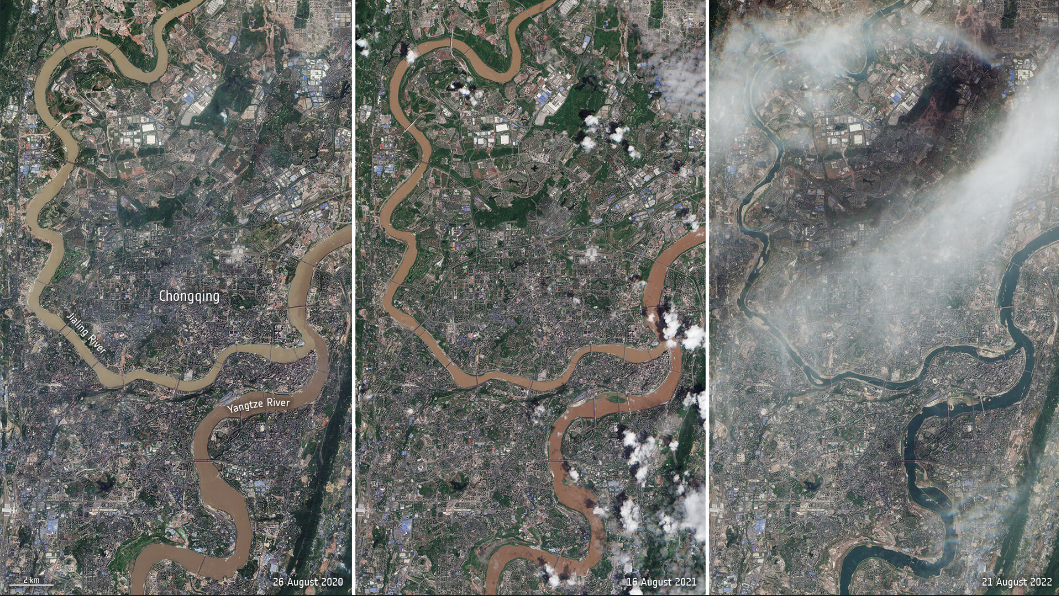
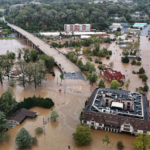
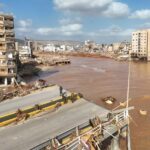
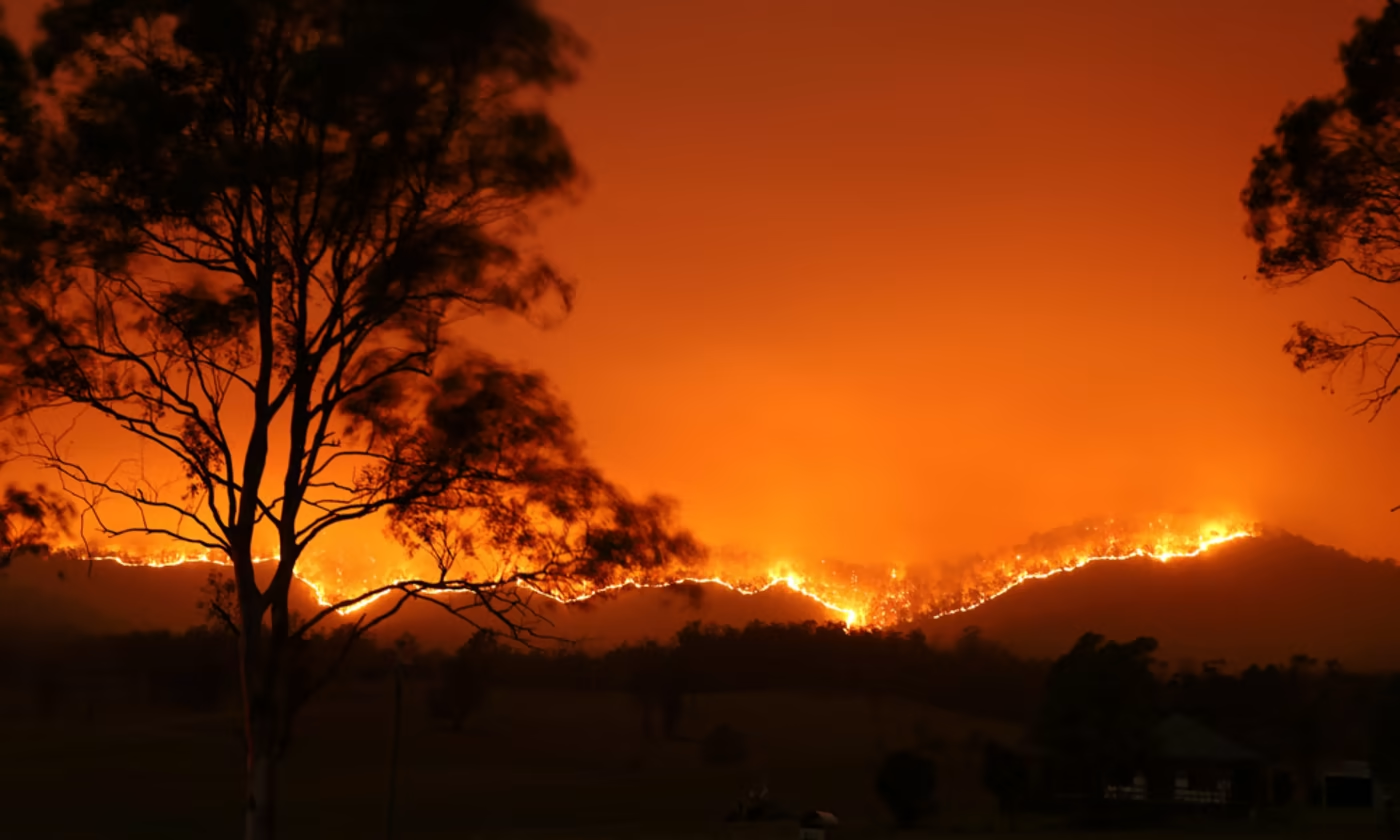
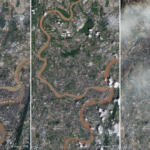


Leave a Reply